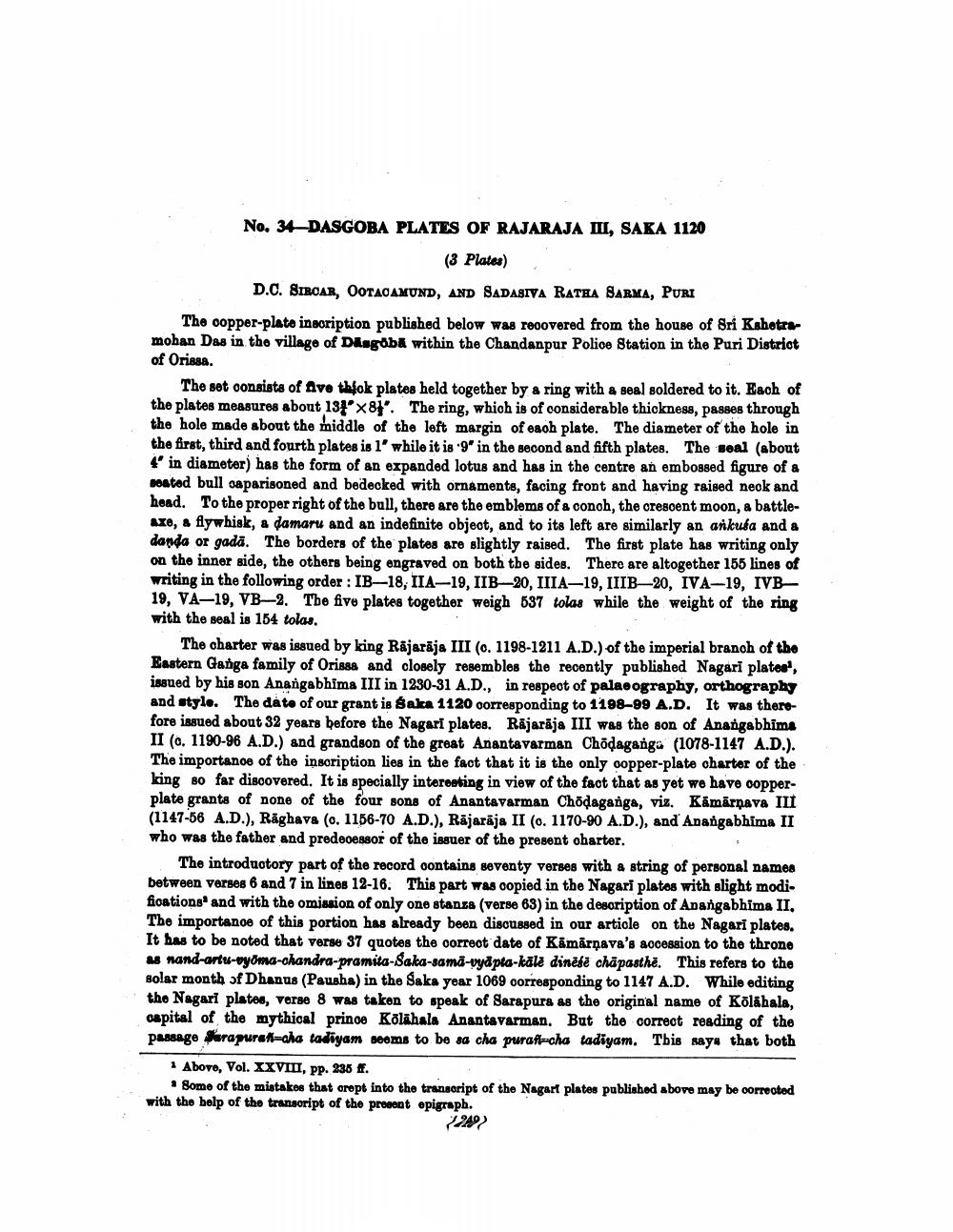________________
No. 34 DASGOBA PLATES OF RAJARAJA III, SAKA 1120
(3 Plates) D.C. SIROAR, OOTACAMUND, AND SADASIVA RATHA SARMA, PURI The oopper-plate inscription published below was recovered from the house of Sri Kshetra mohan Das in the village of Dingöba within the Chandanpur Police Station in the Puri District of Orissa.
The set oonsists of Ave thlok plates held together by a ring with a seal soldered to it. Each of the plates measures about 131' x 81. The ring, which is of considerable thickness, passes through the hole made about the middle of the left margin of each plate. The diameter of the hole in the first, third and fourth plates is l' while it is 9' in the second and fifth plates. The seal (about t' in diameter) has the form of an expanded lotus and has in the centre an embossed figure of a Bosted bull saparisoned and bedecked with ornamente, facing front and having raised neok and head. To the proper right of the bull, there are the emblems of a conoh, the oresoent moon, a battleaxe, a flywhisk, a damaru and an indefinite object, and to its left are similarly an ankusa and a danda or gadā. The borders of the plates are slightly raised. The first plate has writing only on the inner side, the others being engraved on both the sides. There are altogether 155 lines of writing in the following order : IB-18, IIA-19, IIB-20, IIIA-19, IIIB-20, IVA-19, IVB19, VA-19, VB2. The five plates together weigh 637 tolas while the weight of the ring with the seal is 154 tolas.
The charter was issued by king Räjarāja III (c. 1198-1211 A.D.) of the imperial branch of the Eastern Ganga family of Orissa and closely resembles the recently published Nagari plates, issued by his son Anangabhima III in 1230-31 A.D., in respect of palaeography, orthography and style. The date of our grant is Saka 1120 corresponding to 1198-99 A.D. It was therefore issued about 32 years before the Nagari plates. Rajaraja III was the son of Anangabhima II (c. 1190-96 A.D.) and grandson of the great Anantavarman Chödaganga (1078-1147 A.D.). The importance of the inscription lies in the fact that it is the only copper-plate charter of the king so far discovered. It is specially interesting in view of the fact that as yet we have copperplate grants of none of the four sons of Anantavarman Chodaganga, viz. Kämārnava III (1147-66 A.D.), Raghava (o. 1156-70 A.D.), Rājarāja II (o. 1170-90 A.D.), and Anangabhima II who was the father and predecessor of the issuer of the present oharter.
present obarter. The introductory part of the record contains seventy verses with a string of personal names between verses 6 and 7 in lines 12-16. This part was copied in the Nagari platos with slight modifications and with the omission of only one stanza (verse 63) in the description of Anangabhima II. The importance of this portion has already been discussed in our article on the Nagari plates. It has to be noted that vorse 37 quotes the correct date of Kimārnava's accession to the throno a nand-artu-vyöma-chandra-pramita-Saka-sama-vydpta-kala dinese chapasthe. This refers to the solar month of Dhanus (Pausha) in the Saka year 1069 corresponding to 1147 A.D. While editing tho Nagari plates, vorso 8 was takon to speak of Sarapura as the original name of Kölahala, capital of the mythical prince Kolāhala Anantavarman. But the correct reading of the passage Sarapurah-cha tadiyam soms to be sa cha puraft-cha tadiyam. This says that both
1 Above, Vol. XXVIIT, PP. 236 ff.
• Some of the mistakes that crept into the transcript of the Nagart plates published above may be correoted with the belp of the transoript of the procent opigraph.
12492




